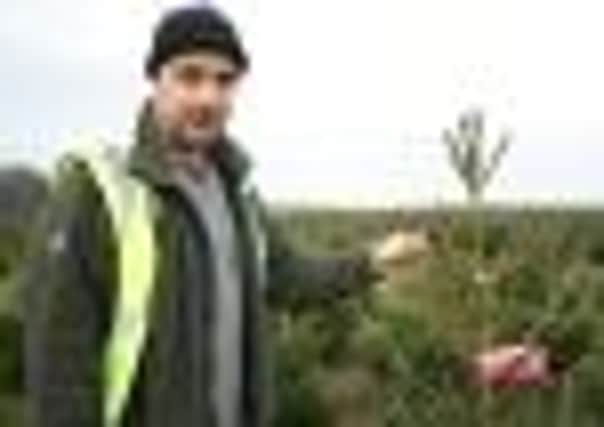Sprucing up our Christmas tree act


Britain is set to regain its place as one of the major suppliers of Christmas trees in Europe thanks to a plantation in the heart of Dalby Forest.
This is a big business. Between 100-150 million families in Europe will put up a real Christmas tree in the next three weeks or so.
Advertisement
Hide AdAdvertisement
Hide AdOften they come from abroad, symbolised by the one which Norway supplies to London for Trafalgar Square each year.
That’s a tradition which began in 1947 to mark the close relationship between the two countries during the war.
But Dalby forest near Pickering is ideally suited to growing Norway Spruce. Not only does it have the right soil, but the shape of the landscape makes it ideal.
“Dalby’s a series of riggs and dales which is flat plateaued areas and good soil conditions,” says Simon Marrington who is the beat manager for the Forestry Commission’s North Riding division.
“And this site suggested itself because of its size.”
Advertisement
Hide AdAdvertisement
Hide AdSimon is responsible for growing all the Commission’s Norway Spruce Christmas trees which are sold around the country.
“We’ve got sandy loam up here which is particularly fertile for them. The only thing about Christmas trees is we don’t want them to get away too fast.” They take eight years to mature - seven years growing and a year fallow.
The plot at Broadheads, the spruce plantation within Dalby, is about 20 hectares and Simon is aiming for a sustainable supply of 10,000 Norway Spruce a year.
Broadheads is on a plateau in a clearing, deep in the forest. Purpose built, it has water tanks to irrigate the trees during dry periods and it’s surrounded by deer-proof fencing.
Advertisement
Hide AdAdvertisement
Hide AdThe first of the trees planted there are maturing now. By happenstance this has turned out to be great timing. The Yorkshire trees are becoming available just at a time when the traditional supply of Christmas trees from Europe is dropping.
“People are beginning to forecast a shortfall, particularly due to the lack of volume coming from Denmark, Germany and Holland,” says Simon.
“So the onus is on us, in terms of supplying ourselves. Many people are predicting a shift, and a shortfall in what’s coming from abroad.”
He says the reasons for the changes is due to the way that subsidies are paid to farmers in the exporting countries.
Advertisement
Hide AdAdvertisement
Hide AdBecause of the eight year planting cycle for these trees, this has come at exactly the right time, especially as more home grown trees may be needed in the future.
“With that forecast and the fact that the Christmas tree market in Britain’s never been more popular, now is a good time for us to be in the market, and having a farm such as Broadheads coming on stream.”
They work on the trees all year round. “We’re up there in the middle of summer shearing the trees - taking off the lower branches - so that people can get them in their plant stands when they put them in their homes.
“We’re shearing them twice a year and we’re leadering them.” The `leader’ is the very top of the tree, where the fairy or the star sits. The growth of the leader shoot is controlled by selecting a bud that will grow in place of the existing leader.
Advertisement
Hide AdAdvertisement
Hide Ad“The bud which you leave, and favour, recovers and that creates a new leader.
“The idea is that we get a nice dense foliage and lots of places to hang your baubles at the end of the day.”
The trees are sheared in order to give them the traditional conical shape, that everyone associates with a Christmas tree.
“It’s done with long handled shears, or knives which look like a bread knife, an elongated bread knife, but extremely sharp.
Advertisement
Hide AdAdvertisement
Hide Ad“We have a mix of contract labour and our own squads are occupied for a percentage of the year.”
The Christmas trees at Dalby provide fulltime employment for several people and recently the Forestry Commission invested in equipment to give them their Christmas wrapping. It’s a netting device which which compresses the branches.
“That’s important, because when we’re looking at moving trees around for national supply we want to put as many trees on a wagon as possible. By using this machine we’ve almost doubled the number of trees we can get on a wagon.”
The trees grown at Dalby will go on sale around the country on Monday.
Advertisement
Hide AdAdvertisement
Hide AdSimon says, touch wood, that Christmas tree demand hasn’t been affected by the recent recession or other problems in the economy.
“The market is really buoyant and people tend to be buying real trees at the moment.
“The trend over recent years has been to buy bigger trees, seven or eight foot are becoming increasingly popular.”
“People see a real tree as a green alternative.
“I’d like to think we’ll be providing trees for many years to come.”
Story of the Christmas tree
Advertisement
Hide AdAdvertisement
Hide AdAround six million trees are sold in Britain each year, of which the Forestry Commission supplies 100,000.
The custom of putting up a decorated fir tree in your home at Christmas began in Germany in the 17th century.
Prince Albert made Christmas trees popular in Britain, when he introduced them to England from Germany.
The Prince wrote in 1847 that his children should “delight in the Christmas tree”.
He also sought to make it a tradition in Britain and presented many trees to schools and army barracks.